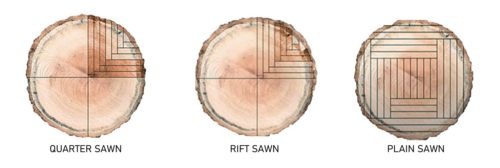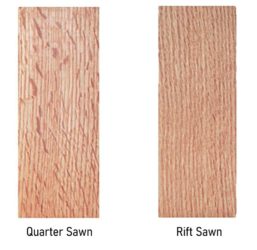When it comes to wood flooring, there are several ways to cut the boards according to style and durability. In this blog, we will discuss the most durable of the methods called rift and quarter sawn. While both options can result in beautiful floors, each method has its unique advantages. We will be taking a closer look at how these boards are made and why you should consider them for your next project.
We will start by breaking down the basics of tree growth. The main feature shown on the ends of flooring is what is called growth rings. One for each year the tree matures, it is shown in the thickness of its circumference. The difference in flooring designs, is where in these growth rings the board is cut.
Rift Sawn Wood Flooring
Rift sawn wood flooring is cut in a way that produces a straight, vertical grain pattern typically between 30-60 degrees. However, the angle of the cut is slightly different than that of quarter sawn in that it results in a narrower grain pattern that is more uniform and consistent. Here are some advantages of using rift sawn wood flooring:
Stability: Rift sawn wood flooring is more stable than other types of wood flooring because the vertical grain pattern allows the wood to expand and contract less with changes in temperature and humidity.
Durability: Because the wood is cut at an angle that avoids the wood’s medullary rays, which are responsible for allowing moisture and other elements to penetrate the wood, rift sawn wood flooring is less prone to splitting and warping.
Uniformity: The narrow, consistent grain pattern of rift sawn wood flooring creates a beautiful, streamlined look that is ideal for modern and contemporary spaces.

Quarter Sawn Wood Flooring
Quarter sawn wood flooring is cut at a 90-degree angle to the tree’s growth rings, resulting in a beautiful, unique grain pattern that is prized for its beauty and durability. Here are some advantages of using quarter sawn wood flooring:
Durability: The unique grain pattern of quarter sawn wood flooring is very similar to that of rift sawn in that it moves in its thickness vs. its width. This type of cut will prevent dramatic seasonal gapping and cupping over time.
Beauty: The distinctive, ribbon-like grain pattern of quarter sawn wood flooring is striking and unique. These ribbon-like patterns are what’s called medullary rays, or essentially the nutrient system that resides mainly in the core of the tree going outward. This is the only cut that allows us to see this feature on that face of the board for certainty, while other cuts might only have a rare board or two.

What you will notice often in the flooring industry is that these two cuts are rarely separated from each other. That is due to two things. One being that the cuts are so similar to each other at its angle that it would take a massive amount of time and manpower to separate the two. Another reason would be cost. Because it is very difficult to separate the two styles and to prevent even further waste, mixing the two keeps the overall price point at a much more affordable cost.
In conclusion, both rift sawn and quarter sawn wood flooring offer a range of advantages that make them excellent choices for any space. Whether you’re looking for durability, stability, or beauty, both options are sure to provide you with a stunning and long-lasting flooring solution.
